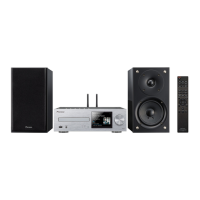
Do you have a question about the Pioneer X-HM76D and is the answer not in the manual?
| Playback disc types | CD, CD-R, CD-RW |
|---|---|
| MP3 playback | Yes |
| Playback disc formats | CD audio |
| Supported radio bands | FM |
| Card reader integrated | No |
| Audio formats supported | AAC, AIFF, DSD, FLAC, MP3, WAV, WMA |
| Preset stations quantity | 40 |
| Internet radio services supported | Deezer, Tidal, Spotify, TuneIn |
| Type | Home audio micro system |
| Product color | Black, Silver, White |
| Number of optical discs | 1 discs |
| Impedance | 4 Ω |
| RMS rated power | 100 W |
| Woofer diameter | 120 mm |
| Tweeter diameter | 25 mm |
| Number of speakers | 2 |
| Total Harmonic Distortion (THD) | 10 % |
| Headphone connectivity | 3.5 mm |
| USB 2.0 ports quantity | USB 2.0 ports have a data transmission speed of 480 Mbps, and are backwards compatible with USB 1.1 ports. You can connect all kinds of peripheral devices to them. |
| Digital audio optical in | 1 |
| Display diagonal | 3.5 \ |
| Bluetooth profiles | A2DP, AVRCP |
| Apple docking compatibility | Not supported |
| Compatible operating systems | iOS, Android |
| Bluetooth version | 4.1 |
| Display type | LCD |
| Power source | AC |
| Main unit weight | 3500 g |
|---|---|
| Rear speaker depth | 217 mm |
| Rear speaker height | 263 mm |
| Rear speaker weight | 3400 g |
| Main unit dimensions (WxDxH) | 290 x 333 x 98 mm |
Main operational buttons, playback controls, USB port, and audio output jack.
Power/timer indicators, remote sensor, and the main display unit.
Power cord, wireless antenna, speaker terminals, and DAB/FM antenna jack.
Line IN, Subwoofer PRE OUT, USB, Network, and Digital Optical input terminals.
Power cord, wireless antenna, speaker terminals, and FM antenna jack.
Line IN, Subwoofer PRE OUT, USB, Network, and Digital Optical input terminals.
Buttons for power, input selection, playback, and navigation.
Buttons for tuning, modes, setup, volume, sound, and display.
Information shown on the display, including file details, playback status, and indicators.
Tweeter, woofer, and the main speaker cabinet structure.
Connections for speaker cables and the bass reflex port.
Tweeter, woofer, and the main speaker cabinet structure.
Connections for speaker cables and the bass reflex port.
Guide to configuring Wi-Fi network connection during initial setup.
Procedure for setting the unit's clock and alarm times.
Instructions for playing standard commercial music CDs.
How to play discs with MP3 and WMA audio files.
Options for custom playback sequences, repetition, and shuffling.
Connecting and playing audio files from USB storage devices.
Listening to internet radio services like Tuneln.
How to add and play favorite stations within Tuneln.
How to use Spotify Connect for wireless audio streaming.
Tuning into FM stations automatically.
Manually tuning, selecting, and managing FM radio stations.
Scanning for and selecting DAB radio stations.
Viewing detailed information about DAB stations.
Connecting a BLUETOOTH enabled device to the unit for the first time.
Streaming audio wirelessly from a paired BLUETOOTH device.
Streaming music wirelessly from Apple devices using AirPlay.
Connecting external devices via optical digital or analog audio cables.
Selecting the correct input for playback from external devices.
Setting up Windows Media Player for network streaming.
Accessing and playing music files stored on network servers.
Configuring Timer 1 and Timer 2 for scheduled playback.
Checking, turning on, or turning off the alarm settings.
Guide to using remote buttons for text input (e.g., passwords).
How to modify bass and treble levels for sound quality.
Configuring network connection type and Wi-Fi setup.
Restoring unit settings to factory defaults.
Updating unit firmware via network or USB.
Configuring network settings via a web browser.
Unit won't turn on or turns off unexpectedly.
No sound from external devices or display issues.
Problems connecting to the network or interrupted playback.
Technical details on audio output power and tuner ranges.
Specs for CD, digital inputs, network, and Bluetooth features.
Power supply, consumption, and standby modes.